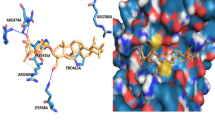Abstract
It has been known that basic fibroblast growth factor (bFGF) plays an important role in tumor progression mainly due to its strong mitogenic activity. Antagonists targeting bFGF have been considered a potential strategy for cancer therapy via inhibiting cell proliferation induced by bFGF. We have previously obtained a high-affinity bFGF-binding peptide (named as P7) with strong inhibitory activity against bFGF-induced cell proliferation from the phage display random heptapeptide library. The aim of the present investigation was to synthesize the peptide P7 by solid phase method and explore the mechanisms of the inhibitory effect of P7-targeting bFGF stimulation on Balb/c 3T3 cells via proteomic analysis. Seven differentially expressed protein were identified, among which four were decreased by bFGF stimulation alone and increased by addition of P7, the other three were up-regulated by bFGF treatment alone and down-regulated by addition of P7. Among the identified proteins, epidermal fatty acid-binding protein (E-FABP) and low molecular weight phosphotyrosine protein phosphatase (LMW-PTP) take part in the regulation of cell proliferation. The results suggested P7 inhibited the bioactivities of bFGF possibly via influencing the expression of cellular proteins related to cell proliferation.




Similar content being viewed by others
References
Beenken A, Mohammadi M (2009) The FGF family: biology, pathophysiology and therapy. Nat Rev Drug Discov 8(3):235–253
Bossard C, Laurell H, Van den Berghe L, Meunier S, Zanibellato C, Prats H (2003) Translokin is an intracellular mediator of FGF-2 trafficking. Nat Cell Biol 5(5):433–439
Bradford MM (1976) A rapid and sensitive method for the quantitation of microgram quantities of protein utilizing the principle of protein–dye binding. Anal Biochem 72:248–254
Bratkovic T (2010) Progress in phage display: evolution of the technique and its application. Cell Mol Life Sci 67(5):749–767
Chuthapisith S, Layfield R, Kerr ID, Eremin O (2007) Principles of proteomics and its applications in cancer. Surgeon 5(1):14–22
Cronauer MV, Schulz WA, Seifert HH, Ackermann R, Burchardt M (2003) Fibroblast growth factors and their receptors in urological cancers: basic research and clinical implications. Eur Urol 43(3):309–319
Dailey L, Ambrosetti D, Mansukhani A, Basilico C (2005) Mechanisms underlying differential responses to FGF signaling. Cytokine Growth Factor Rev 16(2):233–247
Hagens G, Roulin K, Hotz R, Saurat JH, Hellman U, Siegenthaler G (1999) Probable interaction between S100A7 and E-FABP in the cytosol of human keratinocytes from psoriatic scales. Mol Cell Biochem 192(1–2):123–128
Münz M, Zeidler R, Gires O (2005) The tumour-associated antigen EpCAM upregulates the fatty acid binding protein E-FABP. Cancer Lett 225(1):151–157
Neuhoff V, Arold N, Taube D, Ehrhardt W (1988) Improved staining of proteins in polyacrylamide gels including isoelectric focusing gels with clear background at nanogram sensitivity using coomassie brilliant blue G-250 and R-250. Electrophoresis 9(6):255–262
Park EK, Warner N, Mood K, Pawson T, Daar IO (2002) Low-molecular-weight protein tyrosine phosphatase is a positive component of the fibroblast growth factor receptor signaling pathway. Mol Cell Biol 22(10):3404–3414
Pierce JD, Fakhari M, Works KV, Pierce JT, Clancy RL (2007) Understanding proteomics. Nurs Health Sci 9(1):54–60
Rusnati M, Presta M (2007) Fibroblast growth factors/fibroblast growth factor receptors as targets for the development of anti-angiogenesis strategies. Curr Pharm Des 13(20):2025–2044
Samoylova TI, Morrison NE, Globa LP, Cox NR (2006) Peptide phage display: opportunities for development of personalized anti-cancer strategies. Anticancer Agents Med Chem 6(1):9–17
Sørensen V, Nilsen T, Wiedłocha A (2006) Functional diversity of FGF-2 isoforms by intracellular sorting. Bioessays 28(5):504–514
Wang C, Lin S, Nie Y, Jia X, Wang J, Xiao J, Wu J, Li X, Wu X (2010a) Mechanism of antitumor effect of a novel bFGF binding peptide on human colon cancer cells. Cancer Sci 101(5):1212–1218
Wang C, Lin S, Li X, Wu X (2010b) Mechanism of inhibitory effect of P7 on 3T3 cell proliferation induced by basic fibroblast growth factor. ACTA Pharmaceutica Sinica 45(3):314–317
Wu X, Yan Q, Huang Y, Huang H, Su Z, Xiao J, Zeng Y, Wang Y, Nie C, Yang Y, Li X (2010) Isolation of a novel basic FGF-binding peptide with potent antiangiogenetic activity. J Cell Mol Med 14(1–2):351–356
Acknowledgments
This work was supported by grants from the National Natural Science Foundation of China (30973671, 81071800), the Natural Science Foundation of Guangdong Province of China (9151064001000031), the Natural Science Foundation of Zhejiang Province of China (Y2090292), the Fundamental Research Funds for the Central Universities (21609402), the Science and Technology Planning Project of Wenzhou (Y20090244), Guangdong Provincial “Thousand-Hundred-Ten Talent Project” (Wu X), and Guangdong Provincial Key Discipline in Biochemistry and Molecular biology.
Author information
Authors and Affiliations
Corresponding author
Rights and permissions
About this article
Cite this article
Wu, X., Jia, X., Ji, Y. et al. Effects of a Synthetic bFGF Antagonist Peptide on the Proteome of 3T3 Cells Stimulated with bFGF. Int J Pept Res Ther 17, 53–59 (2011). https://doi.org/10.1007/s10989-011-9240-5
Accepted:
Published:
Issue Date:
DOI: https://doi.org/10.1007/s10989-011-9240-5




